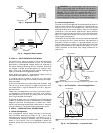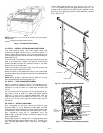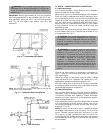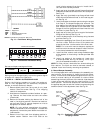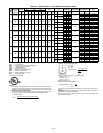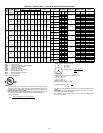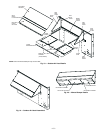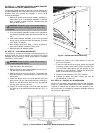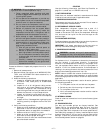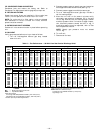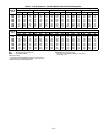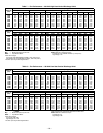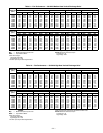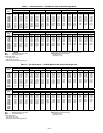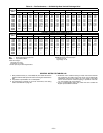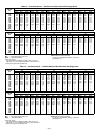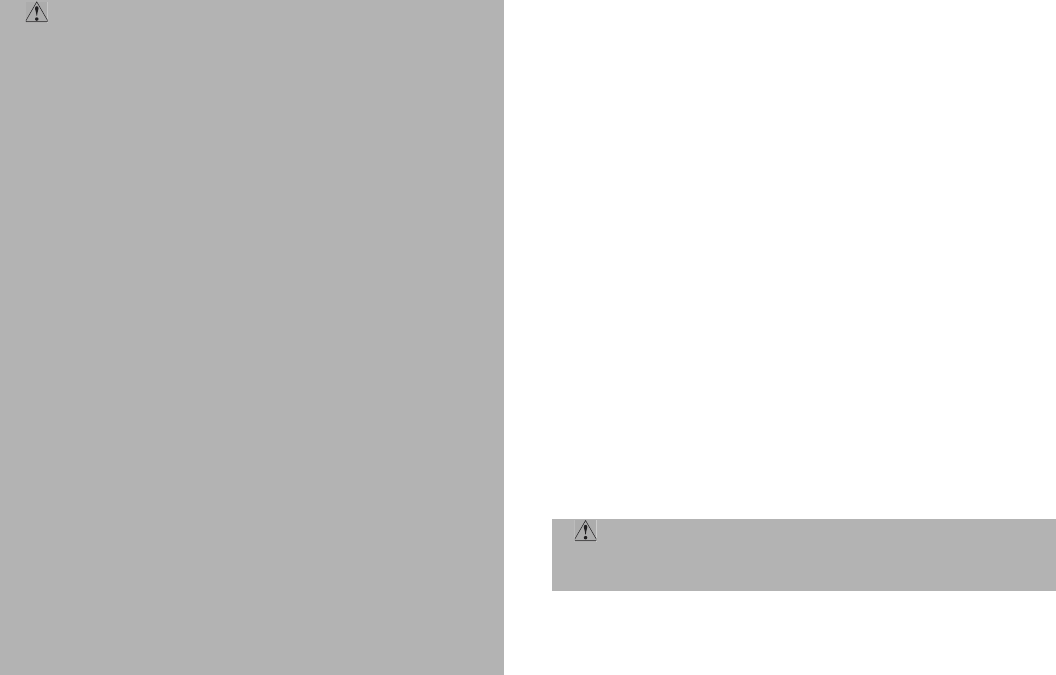
—17—
PRE-START-UP
Proceed as follows to inspect and prepare the unit for initial
start-up:
1. Remove all access panels.
2. Read and follow instructions on all WARNING, CAU-
TION, and INFORMATION labels attached to, or
shipped with, the unit.
3. Make the following inspections:
a. Inspect for shipping and handling damages such
as broken lines, loose parts, or disconnected
wires, etc.
b. Inspect for oil at all refrigerant tubing connec-
tions and on unit base. Detecting oil generally
indicates a refrigerant leak. Leak-test all refrig-
erant tubing connections using an electronic leak
detector, halide torch, or liquid-soap solution.
c. Inspect all field-wiring and factory-wiring con-
nections. Be sure that connections are completed
and tight.
d. Inspect coil fins. If damaged during shipping and
handling, carefully straighten the fins with a fin
comb.
4. Verify the following conditions:
a. Make sure that condenser fan blade is correctly
positioned in the fan orifice. See Condenser-Fan
Adjustment section on page 39 for more details.
b. Make sure that air filter(s) is in place.
c. Make sure that condensate drain trap is filled
with water to ensure proper drainage.
d. Make sure that all tools and miscellaneous loose
parts have been removed.
START-UP
Use the following information and Start-Up Checklist on
page CL-1 to check out unit PRIOR to start-up.
I. UNIT PREPARATION
Check that unit has been installed in accordance with these
installation instructions and all applicable codes.
II. COMPRESSOR MOUNTING
Compressors are internally spring mounted. Do not loosen or
remove compressor holddown bolts.
III. REFRIGERANT SERVICE PORTS
Each independent refrigerant system has a total of 3
Schrader-type service gage ports per circuit. One port is
located on the suction line, one on the compressor discharge
line, and one on the liquid line. Be sure that caps on the
ports are tight.
IV. CRANKCASE HEATER(S)
Crankcase heaters are energized as long as there is power to
the unit and the compressor is not operating.
IMPORTANT: Unit power must be on for 24 hours prior to
start-up. Otherwise, damage to compressor may result.
V. COMPRESSOR PHASING
On 3-phase units, it is important to be certain the compres-
sors are rotating in the proper direction. To determine
whether or not compressors are rotating in the proper direc-
tion, use a phase-rotation meter on the unit input power to
check for L1-L2-L3 or clockwise rotation. If the compressor is
rotating in the wrong direction, the suction pressure will not
drop and the discharge pressure will not rise.
NOTE: Indoor or outdoor fan rotation direction may not indi-
cate proper input power phase sequence, as some 3-phase
units use single-phase fan motors. Check fan rotation where
applicable.
To correct the wrong compressor rotation direction, perform
the following procedure:
1. Turn off power to the unit and lock out the power.
2. Switch any two of the incoming unit power leads.
3. Turn on power to the unit.
4. Verify corrected compressor rotation and fan rotation
where applicable.
VI. INTERNAL WIRING
Check all electrical connections in unit control boxes; tighten
as required.
VII. EVAPORATOR FAN
Fan belt and variable pulleys are factory-installed. See
Tables 5-23 for fan performance data. Be sure that fans
rotate in the proper direction. See Table 24 for air quantity
limits. See Table 25 for evaporator fan motor specifications.
See Table 26 for accessory or factory-installed options static
pressure. See Table 27 for fan rpm at various motor pulley
settings. To alter fan performance, see Evaporator Fan Per-
formance Adjustment section on page 39.
WARNING: Failure to observe the following warn-
ings could result in serious personal injury.
1. Follow recognized safety practices and wear
protective goggles when checking or the servic-
ing refrigerant system.
2. Do not operate the compressor or provide any
electric power to the unit unless the compressor
terminal cover is in place and secured.
3. Do not remove the compressor terminal cover
until all electrical sources are disconnected.
4. Relieve all pressure from the system before
touching or disturbing anything inside the
compressor terminal box if refrigerant leak is
suspected around the compressor terminals.
5. Never attempt to repair a soldered connection
while the refrigerant system is under pressure.
6. Do not use torch to remove any component. The
system contains oil and refrigerant under pres-
sure. To remove a component, wear protective
goggles and proceed as follows:
a. Shut off gas and then electrical power to
the unit. Install lockout tag.
b. Relieve all pressure from the system using
both high-pressure and low-pressure ports.
c. Cut the component connection tubing with
a tubing cutter, and remove the component
from the unit.
d. Carefully unsweat the remaining tubing
stubs when necessary. Oil can ignite when
exposed to torch flame.
WARNING: Improper wiring will cause compres-
sor stoppage and may cause equipment damage. Cor-
rect wiring by switching leads as indicated below.



